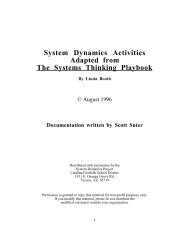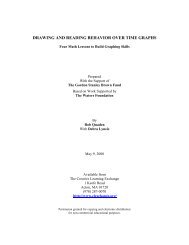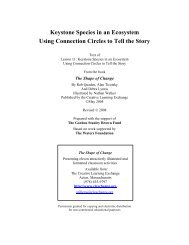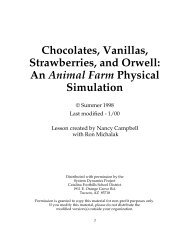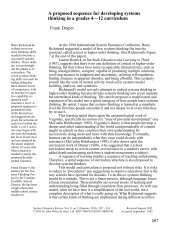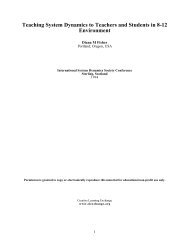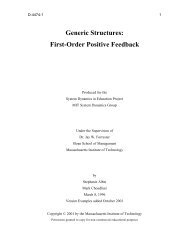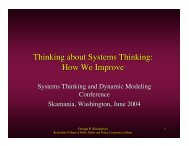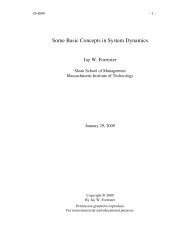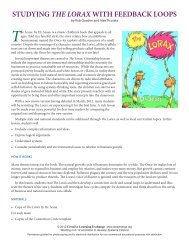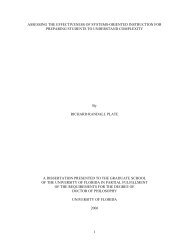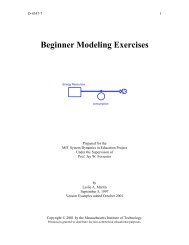Systems thinking: critical thinking skills for the 1990s and beyond
Systems thinking: critical thinking skills for the 1990s and beyond
Systems thinking: critical thinking skills for the 1990s and beyond
- No tags were found...
Create successful ePaper yourself
Turn your PDF publications into a flip-book with our unique Google optimized e-Paper software.
130 System Dynamics Review Volume 9 Number 2 Summer 1993.had shown considerable ingenuity in his <strong>for</strong>ms of degradation <strong>and</strong> punishment.An interesting question was posed: if "John Wayne" could havebeen screened out be<strong>for</strong>e <strong>the</strong> experiment, would <strong>the</strong> results have been <strong>the</strong>same? Was <strong>the</strong> unexpectedly high level of brutality attributable to <strong>the</strong> tonebeing set by this one student guard?From an "if, <strong>the</strong>n, else" viewpoint, one might answer yes: screenout any "John Wayne" types, <strong>and</strong> you'll have a very different prison.From a continuum viewpoint, one might instead argue that people are not"John Wayne" or "not John Wayne." Ra<strong>the</strong>r, we each have <strong>the</strong> capacity<strong>for</strong> manifesting brutal <strong>and</strong> degrading behavior. This situation, dem<strong>and</strong>ingthat guards "control" prisoners, can call <strong>for</strong>th this behavior. The individualmost disposed to manifesting it, does so. Remove that individual, <strong>and</strong> <strong>the</strong>next most disposed will arise to assume this role. A STELLA model ofthis experiment, constructed using a continuous modeling process, didindeed show this result. The conclusion from <strong>the</strong> model, <strong>the</strong>re<strong>for</strong>e, is thatseeking to screen out "John Waynes" is not likely to be an effectiveintervention <strong>for</strong> improving <strong>the</strong> dynamic equilibrium (in real prisons orsimulated ones) between prisoners <strong>and</strong> guards. Instead, some morefundamental change in <strong>the</strong> system is required.A second brief example concerns <strong>the</strong> extreme positions on abortiontaken by members of <strong>the</strong> pro-life <strong>and</strong> pro-choice camps. Who would wantto be labeled anti-life or anti-choice? Yet that is how some in each campsee <strong>the</strong> o<strong>the</strong>r side. Once a debate becomes polarized in this fashion, itbecomes extremely difficult to make any progress in resolving <strong>the</strong> issues.You're ei<strong>the</strong>r "<strong>for</strong> me" or "against me." But, from a continuum st<strong>and</strong>point,"us versus <strong>the</strong>m" disappears. For example, even <strong>the</strong> most ardentpro-choice proponent would never claim it was all right to abort a fetus tenminutes be<strong>for</strong>e full-term delivery. And no pro-life adherent believes that<strong>the</strong> flushing of a live egg due to menstruation really is murder. Byinventing <strong>the</strong>se extreme conditions, it becomes clear that <strong>the</strong> real debate isnot black <strong>and</strong> white. Pro-life people really are pro-choice people undercertain circumstances, <strong>and</strong> pro-choice advocates really subscribe to apro-life position in some cases. Given this perspective, <strong>the</strong> real issue is,Where is <strong>the</strong> common ground? When a piece of protoplasm should beconsidered to have achieved <strong>the</strong> status of a viable human life <strong>for</strong>m is not socut-<strong>and</strong>-dried after all. In place of "us versus <strong>the</strong>m," <strong>the</strong>re is a continuum.The development of continuum <strong>thinking</strong> capability is closelyrelated to <strong>the</strong> development of generic <strong>thinking</strong> <strong>skills</strong>. Both emphasize <strong>the</strong>ability to recognize <strong>the</strong> familiar in what appears diverse or distinct. It's <strong>the</strong>ability to see connections <strong>and</strong> interdependencies ra<strong>the</strong>r than sharpboundaries <strong>and</strong> disconnections. Many continuous models exist that can beused to develop <strong>the</strong> sense of continuum. Using <strong>the</strong>se models is a powerfulprocess <strong>for</strong> building continuum <strong>thinking</strong> capability.



